Photography courtesy of Lowell Washburn, all rights reserved.
It’s late September. Skies are clear and afternoon temperatures have climbed to the mid-70s. Right on cue, migrating great egrets are passing through Northern Iowa. Currently traveling from northern
breeding grounds to southern wintering areas, the huge birds are taking a brief time out to rest and refuel. One flock — totaling a dozen or so birds — has paused to look for fish in a back corner of one of my favorite wetlands. It was late in the day when I first spotted the egrets, and I figured that there was a good chance that at least some of the birds would return again in the morning. If they did, I planned to be waiting — camera in hand.
When it comes to exhibiting a commanding level of “stage presence”, few — if any — bird species can top the egret. With its elegant design, stately demeanor, and snow white plumage; the great egret is in a class of its own. Stealthily stalking river backwaters and wetland shallows, the egret is as deadly a spear-fisherman as you’ll ever encounter. On more than one occasion I’ve seen a bird go ‘four straight’ on successful strikes at fish.
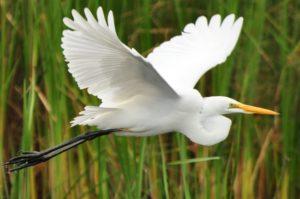
Unfortunately for photographers and other human observers, the egret is as wary as it is efficient. Hair triggered and nervous, the birds take wing at the slightest hint of danger. But in this particular case, I had a possible solution to the species’ natural wariness. I would arrive back at the wetland while it was still pitch dark, wade out into the marsh, and quietly install a portable pop-up blind. After that, I would wait. With the approach of daylight, the egrets would hopefully return to feed.
All of a sudden, an additional strategy popped into my head. Driving to the Mason City Fleet Farm store, I purchased a plastic great blue heron. Heron decoys are commonly used as yard and garden ornaments around waterfront properties or by duck hunters as ‘confidence decoys’ in order to make their waterfowl spreads look more convincing. But what I had in mind for the bird was something radically different. Upon arriving home, I used a coat of flat white house paint to convert heron to egret. By staking the effigy close to my blind, I hoped to provide an incentive for incoming egrets to land nearby.
Whether or not plastic egret facsimiles would effectively draw live birds closer was anybody’s guess. Nevertheless, I was excited over the prospects and had a hard time sleeping. I finally gave up and headed back to the marsh; arriving more than an hour before daylight. But although the sun wasn’t shining, the light provided by an icy white September moon was flooding the landscape. Much to my wonder, great egrets — dozens of them — were already flying by the light of the moon. Geese were also on the wing, and I quickly realized that I had found myself in the middle of a late night bird migration. The birds kept flying by and I dug out the camera. I kept turning up the settings until I could finally get some rather grainy, but unusual, photos to document the event.
Putting the camera away, I loaded up my stuff and began wading toward where the egrets had been feeding the day before. Once the blind was up, I put out my ‘spread’ — at which time I discovered that it takes a whole lot less time and effort to put out one egret effigy than it does to toss out dozens of duck or goose decoys.
Sitting in chest waders, in the water and in the dark; I slowly rationed the thermos of coffee I’d included in my pack. The coffee held out until daylight finally arrived and low flying ducks began buzzing the marsh. A few nearby red-wings started to stir in the cattails and I could hear Canada geese discussing the day’s plans. As the morning slowly grew lighter and brighter, I saw and heard just about everything except what I’d come for. There was not so much as a single egret to be seen — anywhere. And then I heard it: the soft rustle of wings and a barely audible, nearby splash. I turned my head, and there it was — a huge and magnificent, snow white bird standing just feet away. The egret had landed. The bird had come in from behind the blind and was now intently staring at its plastic counterpart. The egret was tight feathered and tense, ready to leap back into the air at the drop of a hat. Then, suddenly deciding that all was well, the bird relaxed and began to slowly stalk the edge of the cattails, looking for fish. A second egret appeared, then another and another. Traffic steadily picked up until I was eventually surrounded by dozens of the huge, long legged waders — many more than I had seen the day before.

It was now full light and the day’s fishing began in earnest. Each bird charted its own course — cautiously creeping, watching, and peering into the water with incredible intensity. With acute accuracy, the long necked waterbirds began to thrust their spears; picking off their scaly targets one by one.
Some fishing spots were better than others and this is where the birds soon began to concentrate. But fishing is serious business for egrets, and competition is not always welcome or accepted. Consequently, the feeding birds remained in a constant state of turmoil as they vied and fought for the best positions. As soon as one spot was ‘burned out’ the egrets would began to adjust and relocate, always on the lookout for someone doing better than they were. The show continued as more egrets continued to arrive. A morning highlight occurred when I saw one bird capture two fish in a single strike. As the egret swallowed its catch, I could see the first fish — appearing as a big lump in the gullet — going down the hatch while the second fish was still secured in the egret’s stiletto-like bill. After eating their fill, some of the egrets flew to nearby willows to loaf and preen. By the time late morning rolled around, most of the birds were done feeding and had left the marsh. The migration continued. Only six egrets returned to the marsh the following morning; and there were no egrets the day after that.

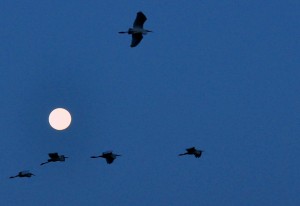
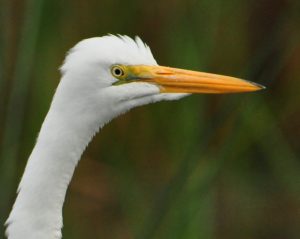
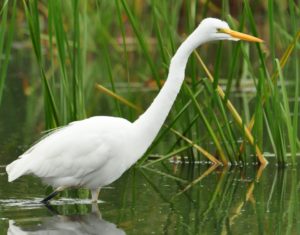
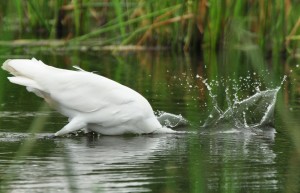
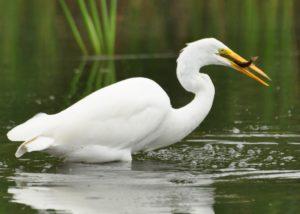
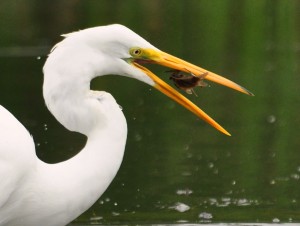
 Tom Cope
Tom Cope Sue Wilkinson
Sue Wilkinson Susan Judkins Josten
Susan Judkins Josten Rudi Roeslein
Rudi Roeslein Elyssa McFarland
Elyssa McFarland Mark Langgin
Mark Langgin Adam Janke
Adam Janke Joe Henry
Joe Henry Kristin Ashenbrenner
Kristin Ashenbrenner Joe Wilkinson
Joe Wilkinson Dr. Tammy Mildenstein
Dr. Tammy Mildenstein Sean McMahon
Sean McMahon